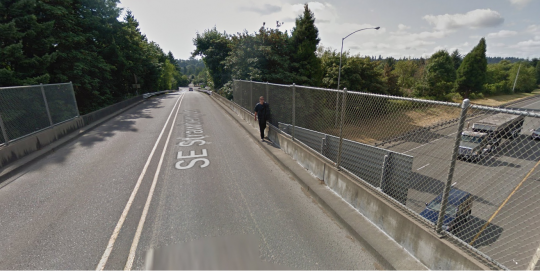
(Images: Google Street View)
Despite receiving a dozen public requests to add sidewalks to an overpass it’s planning to raise by 18 inches, the Oregon Department of Transportation says there’s no room for them in the $3 million project.
Instead, ODOT will add a five-foot-wide striped walking and biking lane on the bridge’s eastbound side. The road-level lane will be marked with a pedestrian symbol.
The Strawberry Lane bridge south of Clackamas is the only crossing of Interstate 205 for one mile in each direction.
As reported Wednesday by the Clackamas Review, the purpose of the project is to raise the overpass enough to prevent most large-load trucks from having to detour onto Strawberry Lane in order to avoid the relatively low bridge.
Without the bridge-raising project, more large trucks would begin using Strawberry Lane because their current detour on 82nd Drive is being blocked by the state’s $118 million construction of a new highway, state route 224. According to the official project website, construction is scheduled to begin in late spring or early summer and wrap up by late summer.
“Why is there no mention of a sidewalk?”
As the Review’s Raymond Rendleman reported, of the 36 comments ODOT received or answered during its local public outreach on the project last year, 12 of them asked for essentially the same thing:
Increase pedestrian and bike availability – the current situation is scary and dangerous, but the Strawberry overpass is a vital connector to east-side shopping, dining, recreation, and other opportunities which are not immediately available to the abundance of pedestrians and bikers living on the west side (of the interstate).
We live on Tiffany Ct. and would love to be able to walk to the park on Strawberry Lane. We have 3 teenagers as well as 3 dogs that would love to be able to walk there. Unfortunately, there are no sidewalks or even a bike lane on Strawberry Lane between 205 and 82nd, and there’s none on the bridge either. Would it be possible to add a sidewalk or bike lane, even on just one side? This would be a great asset to the residents on Tiffany Ct, as well as all the residents of the apartments on 82nd just up from Strawberry Lane.
I’m concerned about the lack of additional improvement to the overpass. Why is there no mention of a sidewalk?
I have a daughter that lives on the West side of I-205 and I cross that overpass frequently in my car and there is always pedestrians crossing that bridge to access the sidewalks to Fred Meyers and other businesses on the East side of I-205. It is extremely dangerous with the arch of the bridge and visibility of both pedestrians and drivers coming up on each other, and now the arch is going to be even higher! What are you folks thinking? That route is a full use road! There are bicycles, pedestrians and cars that use that overpass 24/7 and there is already a safety issue now, and you folks are going to make it worse for bikes and pedestrians with no improvement!
What’s up with that?
Sounds like the only thing ODOT is concerned about is truckers moving product and zero concern for public safety!
While making the bridge safe for pedestrians is probably beyond the scope of the project, it does seem reasonable that some improvements could be made on the approaches to the actual bridge structure.
Since some re-grading and retaining walls are required, I would hope that at least the approaches would have some improvements for pedestrians. Obviously the bridge doesn’t meet modern standards, but it would be a shame to see it raised for over-sized loads and seismically retrofitted without addressing the extreme hazards pedestrians face using the bridge.
Advertisement
Can ODOT add a sidewalk or bike lane on Strawberry Lane between I-205 and 82nd Drive as part of this project?
It would have been nice to have a ped-friendly width on the bridge.
Bikes and people are hazard on bridge.
Would be nice to have more space for walkers/bikers.
We need a walking path on Strawberry Lane.
Pedestrians and bicyclists are a potential hazard on narrow bridge.
This JTA project needs to include addition of ped/bike crossing. One suggestion is hanging lightweight structure off bridge structure. Another is detached within R/W or alternate location within 600 ft.
Last night I attended the Clackamas CPO (Community Planning Organization). There was a concern about the lifting of the Strawberry Lane overpass because the design lacks sidewalks and bike lanes. Does anyone have any information on this? (forwarded to ODOT by Metro)
In its responses last year, ODOT offered the same answer to each of these people:
Unfortunately, adding a sidewalk or a bike lane is not in ODOT’s budget as a component of this project at this time but it doesn’t preclude adding a sidewalk or bike lane sometime in the future.
However, at the request of Clackamas County, ODOT has since agreed to narrow the travel lanes and paint a white stripe onto the north side of the bridge to mark a space for biking or walking, and to mark the space with a pedestrian symbol. The state transportation agency also plans to add sharrow markings in the general travel lanes to indicate that people are allowed to bike on the east-side ramp off the bridge.
ODOT says it is also considering allowing the speed limit on Strawberry Lane to fall to 25 mph. The street is currently posted at 35 mph.
ODOT: Raised sidewalk would have created biking-walking conflicts
Jessica Horning, ODOT’s regional transit and active transportation liaison, said Thursday that rebuilding the bridge to widen it would have increased the project cost 10 times or more. She said she didn’t know whether anyone considered the feasibility of hanging structures from the sides of the bridge, but that she assumed someone would have.
Could the vehicular lanes be narrowed further? Horning said they are as narrow as they can reasonably get — 10 feet eastbound, 11 feet westbound — given the fact that they have to carry TriMet’s No. 79 bus line.
What about creating a raised five-foot-wide sidewalk? She said that was out because of possible cost considerations and because it might create conflicts between people walking and people who would choose to bike on what would be a steep uphill sidewalk.
“It seemed like doing a stripe you could let the bikes and the pedestrians use the space with more flexibility,” Horning said. “It’s one of those projects that we couldn’t get the ideal, but we did a pretty good job of using the space pretty creatively.”
Horning said that though the roadway is being “relocated” upward and would therefore seem to trigger Oregon’s law requiring all such projects to include bikeways and walkways, “we are providing pedestrian and bicycle accomodations” in the form of the painted biking-walking lane and the sharrow markings.
Gwenn Laubach Alvarez of the Clackamas County Pedestrian and Bicycle Advisory Council said in an email Thursday that when ODOT spoke to her council, the council “made it clear that it wasn’t pleased with the proposals.”
“There are certain members of the Clackamas County Commission who oppose any road funding that isn’t funneled into improving highways and existing conditions for commercial traffic,” Laubach Alvarez said. “ODOT is not immune to feeling the pressure from those commercial interests.”
Speaking Wednesday at a demonstration that urged ODOT to prioritize safety for people driving, walking and biking on its roads above speed or traffic capacity, ODOT spokesman Don Hamilton said “we prioritize the issues based on safety” and that the agency is “already putting a lot of money into a lot of safety projects” on its dangerous streets.
He said that ODOT’s safety improvements on dangerous streets can take years to implement because the agency needs time to hear from its stakeholders.
Thanks to Clackamas Review reporter Raymond Rendleman for forwarding us the transcript of public comments received by ODOT.
Correction 5/19: An earlier version of this post said the legal speed limit across the bridge was unspecified. It’s 35 mph.


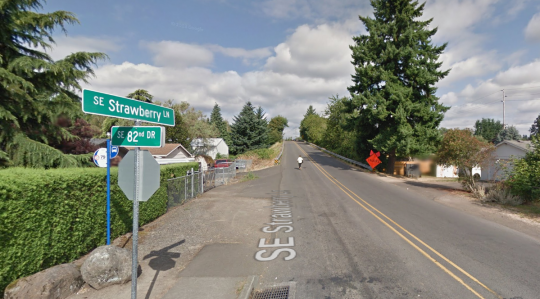
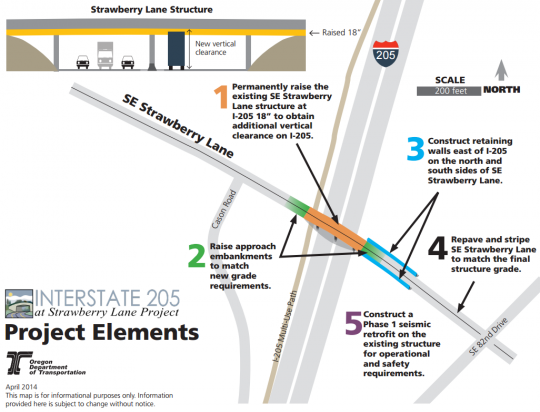
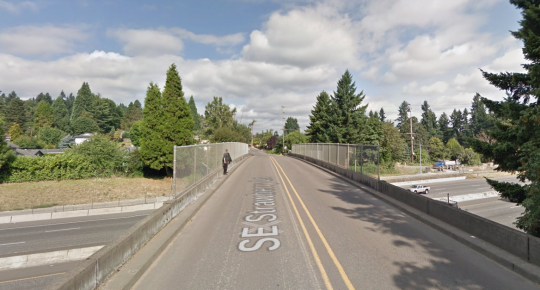

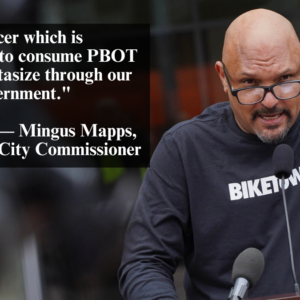
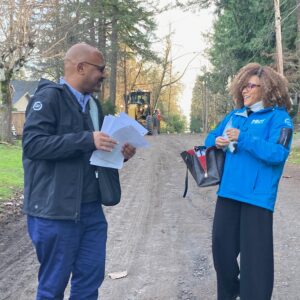
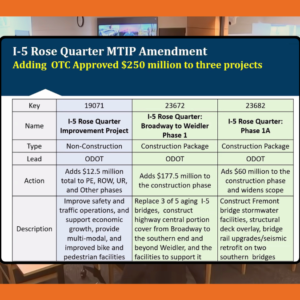
Thanks for reading.
BikePortland has served this community with independent community journalism since 2005. We rely on subscriptions from readers like you to survive. Your financial support is vital in keeping this valuable resource alive and well.
Please subscribe today to strengthen and expand our work.
Huh? I want to hear the rest of the story… It just doesn’t all make sense.
I’m not sure there *is* a “rest of the story”. This is only a $3M project. It’s pocket change. Rebuilding the bridge in this area would be at minimum a $15M project. The existing structure and roadway is REALLY narrow – they’re not kidding when they say the road can’t be narrowed further for bike lanes/sidewalks with the existing lane widths.
There is, however, an option not being looked at, and which should be: Reduce the travel lanes to a single lane, and put a signal at either end of the bridge allowing one-way car travel at a time. (14′ of lane) Take the remaining 8′ of ROW and put in K-rails to build a protected bike/ped path on one side. You’d add a few hundred thousand dollars of cost for the signals, but get a safer crossing. That road doesn’t have the traffic volume to need both lanes, and reducing to a single signalized lane will have the added effect of reducing traffic speeds on Strawberry Lane.
Unless you know something I don’t, Matt, I think the bridge offers 26 feet of width to play with (5 feet + 11 feet + 10 feet is the lane alignment currently planned) so I think you could do a 14 foot center travel lane with a 6-foot sidewalk or protected bike lane on each side. If you wanted.
This seems like a waste of $3 million. How many trucks have to detour each year? Given the exits just north and south of this bridge, it seems that 82nd is an easy detour that would barely add travel time for the tiny amount of vehicles that cannot fit under this bridge.
“Without the bridge-raising project, more large trucks would begin using Strawberry Lane because their current detour on 82nd Drive is being blocked by the state’s $118 million construction of a new highway, state route 224.”
Is that a $3 million problem?
I’m just pointing out that 82nd could not serve as a detour anymore, since it is being blocked. The next “logical” choice for truck drivers is apparently Strawberry Lane, which is evidently undesirable, even temporarily (I don’t know whether 82nd will be unblocked after the other project is completed), so the overpass is being lifted. I can’t say how much lifting an overpass should cost.
Chris has a good point – why isn’t some of the $118M for the 224 project being used to mitigate traffic impacts from construction?
For all I know, $3M of a $121M project is being used to mitigate traffic impacts from the 224 construction…
What about making this a 1-lane bridge. In case you aren’t getting it- they aren’t rebuilding the bridge, just lifting it
Heh, I just posted the exact same thing. Hadn’t reloaded the page to see you comment before leaving mine.
First this: Unfortunately, adding a sidewalk or a bike lane is not in ODOT’s budget as a component of this project at this time but it doesn’t preclude adding a sidewalk or bike lane sometime in the future.
Then this: Horning said that though the roadway is being “relocated” upward and would therefore seem to trigger Oregon’s law requiring all such projects to include bikeways and walkways, “we are providing pedestrian and bicycle accomodations” in the form of the painted biking-walking lane and the sharrow markings.
So ODOT was willing to illegally upgrade the project before they realized that would be against the law? Is that what is happening here. ODOT needs to be disbanded and rebuilt from the ground up– it is corrupt to its core with only supporting freight and speed at the cost of all else.
It’s not just ODOT. This is pretty much all 50 state DOTs.
it’s not against the law because there’s an exception when it costs too much… so most agencies will just get a high estimate on adding ped/bike facilities and then use that as their excuse…
It’s the same creative interpretation of the law ODOT applied to the Newbury and Vermont bridges on Barbur.
Which is why it isn’t actually very creative. 🙂
Put a stop sign at either end, make it a one-lane bridge with wide MUPs on each side. Every car must come to a stop and yield to the oncoming car waiting on the other side. Make the guzzlers second-class citizens for once. The shipping lobby is already getting its way on the freeway below.
Another option besides a stop sign at each end would be a traffic signal that allows alternating traffic. That’s what they sometimes use in construction zones.
I was going to say basically the same thing: single lane, woonerf, really good lighting and very VERY obvious stop AND speed cameras.
yield sign would do. Or just a sign that says “narrow bridge”. Two motorcycles would pass with no trouble.
Time for another die-in!
this.
Once again, goods movement continues to be the most highly subsidized mode of transportation while other ones don’t even get crumbs.
Time to keep pressuring them though. Also, work on having it a policy that anytime any work is done to a bridge, or a new bridge is going to be made, that wide cycling and walking paths be part of it. It should just be standard and expected everywhere.
ODOT is doing its best for safety, my ass.
Compartmentalized thinking. It is not a bridge safety project. It is a highway capacity – hole in the air – project.
It’s about the road below, not the road above.
and also wrong.
Safety for everyone should be #1 priority and considered in every project. Especially since ODOT just two days ago claimed to be doing its best for safety.
I’m sure that this will be filed under “crazy ideas from out of touch anti-business pinko commie”, but why not just keep the bridge as-is and decrease the height of large-load trucks that are allowed on the roads?
or, maybe, lower the freeway?
At 10x the cost.
You could just hand out $100 bills to everyone crossing there on foot and come out ahead, financially.
But why is it that ODOT always manages to screw this up like this? Communicate that pedestrians are a complete afterthought when it comes to their projects, their priorities, their conception of what matters.
“…What about creating a raised five-foot-wide sidewalk? She said that was out because of possible cost considerations and because it might create conflicts between people walking and people who would choose to bike on what would be a steep uphill sidewalk. …” bikeportland
As an option to enable and support safe use of the bridge, a raised five-foot-wide sidewalk should not be considered “out”, at least until some idea of cost to install one is established and considered.
Jessica Horning, ODOT’s regional transit and active transportation liaison, is the ‘She’ mentioned in the above excerpt. Ms Horning would do well to come up with a little better answer from her department. The top picture accompanying this story shows someone walking on an existing sidewalk on the bridge; very narrow, guessing 24″: Widen that sidewalk an additional 3 feet doesn’t seem like something that would be a big expense.
Conflicts between people walking and people biking on a five foot bridge sidewalk, is a serious consideration. There likely will be some conflicts of that sort, but for people on foot especially, that may be less worse than having to walk on the bridge deck on a painted off bike-pedestrian lane.
“Ms Horning would do well to come up with a little better answer from her department.”
Yes. But we’ve been down this [sidewalk] before here. It is by now abundantly clear that ODOT doesn’t empower Ms. Horning, or anyone else in a position like hers, to communicate anything logical, useful, compassionate in situations like this. Jilayne Jordan used to be the fall person when it came to questions like this on Barbur. I can’t imagine how frustrating it must be to work for an organization that is stuck in a Cold War mindset, refuses to talk in a language that acknowledges that people move about in ways other than behind a windshield.
http://bikeportland.org/2013/01/08/odot-urged-to-consider-better-bike-access-on-barbur-blvd-bridges-81704
Unfortunately by not suing ODOT over their failure to follow the law on the St. John’s Bridge in 2005 the BTA waved the white flag in general on this issue. The only thing that was keeping ODOT honest was the threat of a lawsuit and without that they now feel they can do whatever they want.
Maybe some other organization needs to sue ODOT over this.
I appreciate that there might be good people at ODOT just like there might be good officers in the Baltimore Police Department, but sometimes, I think they are all tainted just by working there.
This is a case in point.
“We’re doing our best.”
Your best isn’t good enough.
More substandard infrastructure from ODOT designed to kill pedestrians and cyclists so drivers can shave 1 minute off their drive time.
This is a great spot for an advisory bike lane. The visibility isn’t ideal because of the crest of the bridge, but the traffic volumes are low enough that 6 ft advisory shoulders could be added to each side of the roadway.
Link to a story from a few years back about Twin Cities’ introduction to advisory bike lanes: http://www.startribune.com/advisory-bike-lanes-baffle-some-in-edina/175033891/#
I’d not heard of them before, haven’t driven or ridden on one. Not sure how well they’d work for this bridge, which is a long one. Lowering the speed limit to 25 is a good idea, even lower, to 20mph could be good.
Plus a PMUFL sign… Pedestrians May Use Full Lane.
What part of ORS permits an advisory bike lane?
Call it a one lane road with dotted edge lines if you want. This is not something that needs to be defined in ORS. It works, it’s simple and it’s cheap.
Are you willing to put your PE license on the line for that opinion? Taxpayer funds for liability?
From the recent die-in at ODOT offices:
Standing on the sidewalk nearby, ODOT spokesman Don Hamilton said the agency was “already putting a lot of money into a lot of safety projects”… “We’ve got fairly aggressive safety projects going in on them all right now,” he said.
ODOT response to actual project:
“Unfortunately, adding a sidewalk or a bike lane is not in ODOT’s budget as a component of this project at this time but it doesn’t preclude adding a sidewalk or bike lane sometime in the future.”
Exactly. Why does everything out of ODOT make me want to throw up? Why couldn’t they, just once, get it right? Why does mendacity seem to always trump honesty over there?
Thanks for bringing this to our attention, bikeportland. Wow.
At the very least they could try not lying to our faces.
being that it’s all residential it should already be at 25…
excessively high speeds limits are another ODOT failure…
btw, it’s posted 35 MPH after you get across the bridge going west… and it’s posted 35 where it starts eastbound at Webster…
since there’s no speed limit sign right when you turn off of 82nd then the basic speed law says that it 25 until you get across the bridge and get to the 35 sign… so it’s sort of half 25 mph on the bridge already…
Statutory speed law is defined in ORS 811.111 and Residence district in ORS 801.
To be considered a residence district, the driveways have to be closer than an average of 150 feet apart.
Strawberry is posted as 35? I went through Google images and couldn’t find a sign but must have missed one. The online speed limit databases I looked up also said the speed limit on Strawberry was unspecified.
Michael – this would be why you (and everyone else) missed the speed limit sign for Strawberry Lane: https://www.google.com/maps/@45.40123,-122.585238,3a,75y,117.07h,66.73t/data=!3m4!1e1!3m2!1sQWz-ZCyRI3zRKwoJwz4Hhw!2e0
The one on the WB side is west of (after) the bridge: https://www.google.com/maps/@45.398356,-122.575265,3a,75y,306.64h,67.63t/data=!3m4!1e1!3m2!1szTIazVqvg8cY5ur6-mJ4gA!2e0
Good lord. Thanks, Matt.
A few years back I e-mailed the project manager of the hanging walk/bikeway on the south side of the Lombard-Marine drive overpass of the Columbia River Slough near the entrance of Kelly Point Park.
Admitedly it was constructed mostly from spare parts, but is came is at about $12 a square foot. Someone needs to ask for all the ODOT communications about ‘The assumption someome looked into this.”
If ODOT did not, or has a REALLY good reason WHY this can not happen, this is a lawsuit. Why shoukld we trust ODOT with a Vision Zero idea with projects like this?
A White stripe? Paint?
Looking at satalite view, i would say that the same treatment couls easily be done here. Some trees may need to be cut, but is would end on a roadway without sicdwalk.
Politcal Burocratic homeowrk. ODOT, deisgn and built this hanging walkway.
Calckamas County (or local jurisiction): Build a SIDEWALK to 82nd.
Yes, it is always dangerous to assume that highway engineers on a retro fit project investigated the option of sticking a hanging bike ped facility…it is hard to see out of one institutional silo into another silo…especially if they do not share the same coffee break/ xerox room.
The ODOT position is outrageous.
ODOT, Don Hamilton, this is insulting. That neighborhood needs increased walkability.
Is there any way to stop these projects unless ODOT adds these ped/bike improvements to the budget? Can they budget them in to the project in the first place, and then that is the total cost of the project. That way bike/ped enhancements won’t be thought of as separate projects that will most likely never have the funding. Or no?
As a whole I’m getting pretty sick of ODOT. I kinda want to throw them away wholly. Not recycle or compost them, just directly toss ’em in to the landfill.
I’m sorry, but maybe we have to go here. You know how Fritz got the wires for highways so quickly pushed through? We need to convince Fritz that bike safety is JUST AS IMPORTANT for lives like her husband’s.
Mistook for portland.
Still a valid complaint though. When it’s for someone personal to Fritz, it gets fast-tracked. But anyone else, her priorities for safety are non-existent.
That’s unfair and insensitive. Granted, that project was likely prioritized for inappropriate reasons following a high-profile incident, when you consider all the other safety improvements that could be made to ODOT roads. However, Fritz isn’t responsible for the post facto decision by ODOT to implement that project. The project wasn’t “for someone personal to Fritz”; neither she nor her husband won anything in that deal.
In response to the remark posted by Adam H. :
“That’s unfair and insensitive. …” Daniel Costantino
And thoughtless, with no grounds whatsoever to back the claim up. Just plain meanness.
If pedestrians had to register their shoes, there would be money for sidewalks.
http://www.vtpi.org/whoserd.pdf
I also wonder if this project is bringing this overpass up to current seismic standards. If not, it seems like they should hold out until they can fund a full replacement with bike lanes and sidewalks, built to current seismic standards.
ODOT’s road budget should be entirely devoted to safety improvements, seismic projects, and repaving. No capacity expansion until every bridge in the state is safe and all roads can be accessed by all users.
Bring up some state legislation making them include these in every project? I’m trying to think of something bigger because we can talk all day every day to ODOT as they currently exist and it seems to fall on deaf ears. Or at least pandering and condescending ears.
You mean bring up something like ORS 366.514, which reads:
(1) Out of the funds received by the department or by any county or city from the State Highway Fund reasonable amounts shall be expended as necessary to provide footpaths and bicycle trails, including curb cuts or ramps as part of the project.
and
Footpaths and bicycle trails, including curb cuts or ramps as part of the project, shall be provided wherever a highway, road or street is being constructed, reconstructed or relocated.
Yeah J_R, that’s what I mean. Thank you.
SO am I missing something. I get that most people on here don’t think this is an optimal (or the perfect) solution. But most of the comments to the project were asking for just SOME kind of improvement. And a shared ped/bike lane is some improvement (in fact one of the comments even specifically suggested it), and does address a number of the comments that were submitted. It appears many of the people got what they were wanting.
“…But most of the comments to the project were asking for just SOME kind of improvement. And a shared ped/bike lane is some improvement (in fact one of the comments even specifically suggested it), and does address a number of the comments that were submitted. It appears many of the people got what they were wanting.” davemess
Doesn’t have to be optimal…but sufficient for safe, comfortable use of the bridge on foot and bike, appears to more than a little important for people residing near this rather long bridge. The sufficiency of a five foot wide painted off section of the bridge deck, for walking directly next to a main lane of traffic is certainly questionable. Seems to me the people appealing to ODOT, were expressing the need for something a little better.
People riding bikes across the bridge, given their generally faster speed, will do better with the painted off MUP, even though it’s planned for only one side of the bridge; especially if ODOT lowers the speed limit to 20, people riding bikes could realistically take the lane instead of the MUP, if it was in use by other people on bikes or people on foot.
Hi Dave,
In a previous comment thread you termed a 4 foot wide door zone bike lane an OK facility. Here you defend a narrow shared in-road facility adjacent to high-speed traffic. I realize that you are playing devils advocate but this design does not even adhere to ODOT’s own design guide:
ftp://ftp.odot.state.or.us/techserv/roadway/web_drawings/HDM/2011%20HDM%20Rewrite/2012%20Appendix%20L%20Bike%20Ped%20Design%20Guide.pdf
Why is ODOT ignoring the law (ORS 366.514) and its own guidelines?
sad
Assuming that this project moves forward and there is no ADA suit…
Come on engineers, y’all are creative types…I guess their ODoT management did not ask the right questions for the SOW and have them “solve’ the problem at this opportunity.
ODoT/ Governor’s Transportation Secretary, note to self…to remember to include active transportation and ADA in project scoping for retrofits and maintenance activities.
(That posit note on the your computer monitor keeps falling down onto the floor, dang need some tape…now where did my assistants put it?!)
Ok, Making design lemonade out of this situation:
– add a 2 inch lift of asphalt with rolled curb transition to the multimodal section (keep at grade near any catch basin);
– lower speed limit to 25 mph (or 20) and add a 3M type active speed watch MPH sign;
– add reflectorized pavement markers inset into the asphalt to help delineate the path zone for poor wether conditions, the RPMs can be spaced far enough apart to not effect cyclists; and
– make sure the path transitions well at both ends to function well for cyclists and safety.
Safety first!!!!
Walking lane? That’s the first I’ve heard of such a thing.
Then you have not had the pleasure yet of outer Powell Blvd, between I-205 and 174th. ODOT added the 3-foot “walking lane” when they resurfaced the roadway a year ago. Combined with the existing 5-foot bike lanes, many motorists use the combined 8-foot zone as a passing lane. Not fun.
“Jessica Horning, ODOT’s regional transit and active transportation liaison, said Thursday that rebuilding the bridge to widen it would have increased the project cost 10 times or more.”
Is it ten times? Or is it more? How do you not know?
“She said she didn’t know whether anyone considered the feasibility of hanging structures from the sides of the bridge, but that she assumed someone would have.”
How do you know it was ten times, if you don’t know if anyone considered feasibility of potentially cheaper options?
Also, what would the cost of a standalone structure be?
“adding a sidewalk or a bike lane is not in ODOT’s budget as a component of this project at this time but it doesn’t preclude adding a sidewalk or bike lane sometime in the future.”
OK but what is the cost difference? How much would it actually (specifically, please) cost to add sidewalks while this major project is underway, and how much would it cost to add sidewalks as a standalone project later? Oh and ODOT… if you don’t have the motivation to do it now, why on earth would you do it later?
ODOT’s arguments are fine. Fine like a fine swiss cheese. Full of holes.
10x seems a bit high, maybe 2x to 5x (Overcrossings near the end):
http://americandreamcoalition.org/highways/HighwayCosts.pdf
A separate ped/bike facility looks like it would cost in the $3M-$10M range:
http://www.cityofpaloalto.org/civicax/filebank/documents/28504/
http://www.cityofsanmateo.org/DocumentCenter/View/37137
For what it’s worth, I also asked these questions of ODOT’s spokespeople on Thursday morning and was told I’d get answers by the end of Thursday. I got a call late Friday (after this post had run) saying they weren’t going to be available. Fortunately, Horning was willing to speak by phone on Thursday and offered these answers (but wasn’t able to answer the questions you ask here, Peter).
http://bikeportland.org/2012/11/27/meet-jessica-horning-odots-new-active-transportation-liaison-79427
the bloom is off the rose. How does one morph from being the ‘active transportation liason’ to ‘apologist’? Painful
This is all the proof we need that ODOT does NOT prioritize safety for bicyclists and pedestrians and that Portland is maybe a Bronze city, but definitely not a Platinum city.
This project is not in Portland.
True, but does the LAB designation apply to only the area within the Portland city limits or does it apply more generally to the Portland region? Or maybe it applies only to the facilities that are strictly and exclusively under control of the City of Portland?
Just City of Portland.
What the (*&^ is a walking lane? Is that like, when you are forced to walk in the street because ODOT doesn’t see fit to pave a sidewalk? I’m looking at you Powell Boulevard. Classic ODOT: safety last.
“…The Strawberry Lane bridge south of Clackamas is the only crossing of Interstate 205 for one mile in each direction.
As reported Wednesday by the Clackamas Review, the purpose of the project is to raise the overpass enough to prevent most large-load trucks from having to detour onto Strawberry Lane in order to avoid the relatively low bridge. …” bikeportland
I also read the Tribune story to try figure out for sure if the above excerpt is saying that part of the purpose of the bridge raising, is to eliminate the need for 1-205 truck traffic, (too tall to get under the bridge), to exit 205 and take the Strawberry Bridge ove 205.
If so, the bridge raising stands to reduce some of the truck traffic using the Strawberry. That truck traffic reduction alone, would be a benefit to people using the bridge on foot and bike. How many trucks a day would that be? Also an important consideration is what is the bridges’ daily amount of motor vehicle traffic.
“That truck traffic reduction alone, would be a benefit to people using the bridge on foot and bike. How many trucks a day would that be?”
Nobody is reducing the number of trucks that currently use the Strawberry Lane bridge. ODOT is closing the currently-used detour of 82nd Drive (due to another $118M project—a new highway!), and fears that the Strawberry Lane bridge would become the new de facto detour. What they are doing is preparing for the closure of the current detour by making it so no detour is required, thereby preventing the use of the bridge by large trucks. This project is an attempt to maintain the current level of use by trucks of the bridge, not reduce it.
We have the same problem in Red Bluff, Ca. There is a very narrow walkway on the I-5 overpass, rather that do a major engineering project of the bridge, it would more simpler to add a prefab walking bridge to either side of the overpass. Just put in some foundation and add the bridge.
Disgraceful but not surprising.
In 2000-01, ODOT undertook an upgrade project for the Ross Island Bridge. In doing that, they narrowed the really narrow curbed area on the south side of the bridge and slightly widened the sidewalk on the north side. I attended the open houses and hearings along with many other people trying to get ODOT to install a wider sidewalk on both sides or a barrier between the cars and sidewalk. They claimed they couldn’t do it due to the weight and structure.
I continue to believe that they could have done both of those things if they had chosen to get rid of the massive, decorative concrete railings on the bridge. What’s frustrating is that the concrete railings were not adequate to stop crashing vehicles, which is why there are steel railings mounted on the bridge that hide the decorative concrete railings. The historic preservation advocates got what they wanted: save the decorative concrete railings; ODOT got steel crash railings; and pedestrians and bicyclists got a shared use path that was only slightly better than what was there before, but didn’t get a facility that protects them from motor vehicles and doesn’t attract much use.
That was 15 years ago. It doesn’t seem like we’ve advanced all that much.
I’d really like to see a follow up to this story about the major construction project happening on 205 & 224 just a bit north of the Strawberry Lane project. There is a missing section of the 205 bike path in that area, and they are not fixing that as part of the project.
Since the overpass we are discussing is in Clackamas county, and since the ODOT is following the wishes of the Clackamas commissioners, and Portland has no say in the matter we should round up the commissioners and families and force them to walk both ways over the overpass WITHOUT MARKERS for a day and then let them vote on it if there are any survivors.
I used to live near the street. I often rode, walked and drove on the overpass across the I-205. It used to be a quiet street. When new development came, it became a bit busier. On the overpass there is no shoulder. It can be a bit hairy sometimes. Poor sight line. You d want to walk against the traffic.
The strength of a bridge is a requirement of the unsupported span, and has little to do with load, and much with length. Adding a sidewalk _and_ a bike lane to each side would not require much change to the basic supporting structure, which they will have to modify to raise it anyway. But then, ODOT would actually have to have a real engineer get out a real slide rule or a real calculator, and spend some time doing real math. Easier just to engage car-head and blow off lesser forms of transportation (Yes, major snark).
Real Engineer=Structural Engineer with Bachelor’s degree, not someone incapable of reading a NACTO manual.
“…Adding a sidewalk _and_ a bike lane to each side would not require much change to the basic supporting structure, … Glenn
Great. What structural changes and or additions to the bridge structure would be required to provide a base for sidewalks and bike lanes on this bridge? A rough estimate in hundreds of thousands of dollars, of what it would cost, would be interesting to know too.
Basically, noting that ODOT’s plan to date is to reconfigure the bridge deck to allow a 5′ MUP on one side of the bridge only: adding structure to the bridge sufficient to have 10′ of sidewalks and bike lanes on the both sides of the bridge would require an additional 15′ of bridge width.
I don’t know how engineers would go about doing that sort of thing, but it doesn’t sound like a simple project.
Maybe whoever gives Jessica Horning her talking points didn’t get this memo:
http://bikeportland.org/2013/05/22/odot-launches-initiative-to-move-away-from-highway-centric-approach-87172
THIS!
If ODOT wants to remain a going concern it needs to represent all parts of the state especially those at the local level near projects. The fact that comments are routinely ignored is just further proof the public process is broken.
If ODOT did not have to take orders from the freight industry, they could forget about this project and apply the $3M to Barbur.
A one lane road wouldn’t work here. There isn’t great visibility for a yield or stop situation. Also, there is not much room between the structure and 82nd Drive. A traffic signal would back traffic onto 82nd Drive. I think the proposed improvements are good for what there is to work with, certainly a much better situation than exists today.
The bridge to no-where. That what Strawberry is. Unless you live off of Strawberrry and work in the Evelyn/Jennifer industrial area and you really want to ride your bike to work, there is little need for a bike facilities. There are better options north and south of there (82nd Dr, 224). And chances are you are probably coming from the north or south anyway.
Its a bridge to an industrial area that I never see cyclists in. I live in the area (just north up 205) and worked down in the that industrial area for several years back in 2008.
I bet if people raised a stink and protested/demanded etc etc, and they did magically find a chunk a money to build a new bridge, the bike lanes would remain pristine and unused for many years afterward.
Spend the $3M Raise the bridge, and save any additional money for more important ODOT projects where cyclists are actually present and their safety is in danger (barbur, 82nd, etc).
Or don’t raise the bridge, and spend the $3 million to improve safety elsewhere. I still haven’t seen enough justification for this expense.
This whole discussion is meaningless without some perspective about the number of cyclists and pedestrians using the bridge. I am a cyclist and a serious pedestrian (meaning, I don’t feel safe riding my bike in the city and do all my errands walking). I live in an area with few sidewalks. I just adapt my walking. I always walk facing traffic, waiting to cross a street if I need to to face traffic. Very few people actually walk where I live. Building sidewalks for a small number of walkers is not only a waste of money, but results in lots of concrete, something our environment has plenty of.
That’s an interesting perspective, Steve. I can relate on one level. I learned to bike before bike lanes were common; did essentially what you are saying you do – just make it work with the existing infrastructure.
But I think the point here is that we’re now in the 21st Century. Cars are on their way out (of course ODOT is in denial about this but that is another matter); non-car modes are in ascendance. People who don’t have or don’t rely heavily on cars also pay into the funds from which ODOT draws its allowance; ODOT’s own language suggests it is aware of the need to stop being a highways-only operation.
You could also say that curb cuts are a waste because in some areas of town there are few to no people in a wheel chair. That the majority mode should get all the funds. But I don’t think we (want to) live in that world anymore.
“This whole discussion is meaningless without some perspective about the number of cyclists and pedestrians using the bridge.”
But look at it this way: On Barbur, where a lot more people on bikes ride—and a great many more likely would if the infrastructure were not so inhospitable—gets the same brush-off from ODOT.
The problem isn’t low use rates as much as it is ODOT’s entrenched mindset that has no time for tiddlywinks modes that don’t have four wheels.